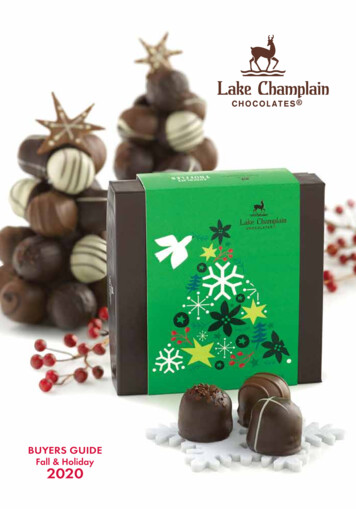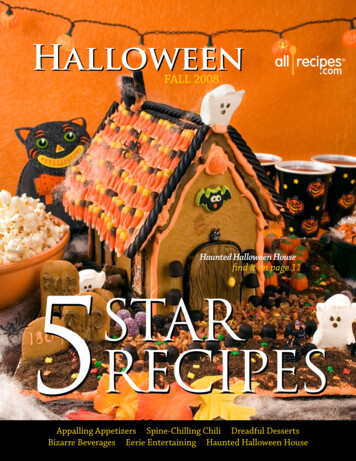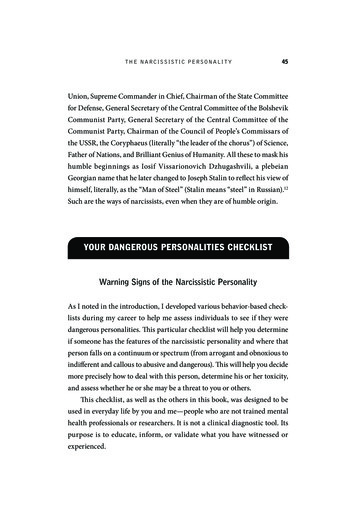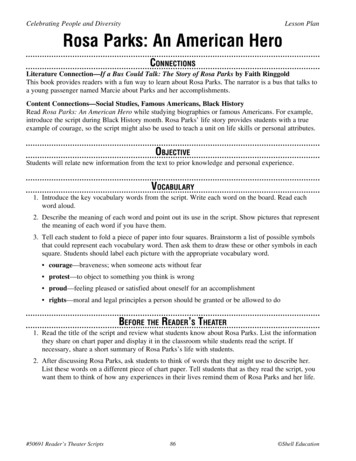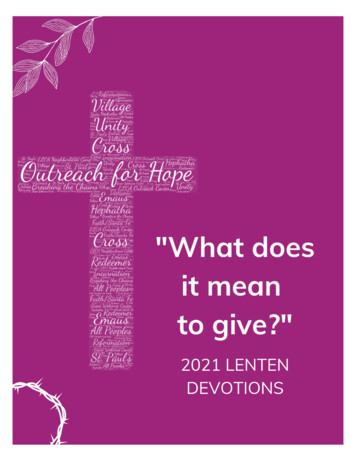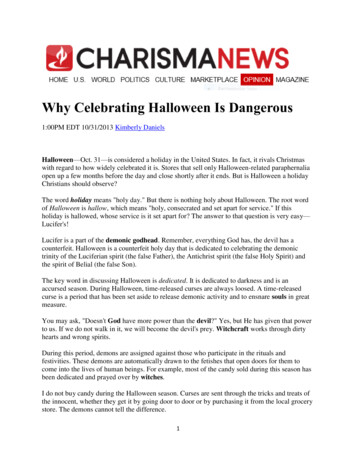
Transcription
Why Celebrating Halloween Is Dangerous1:00PM EDT 10/31/2013 Kimberly DanielsHalloween—Oct. 31—is considered a holiday in the United States. In fact, it rivals Christmaswith regard to how widely celebrated it is. Stores that sell only Halloween-related paraphernaliaopen up a few months before the day and close shortly after it ends. But is Halloween a holidayChristians should observe?The word holiday means "holy day." But there is nothing holy about Halloween. The root wordof Halloween is hallow, which means "holy, consecrated and set apart for service." If thisholiday is hallowed, whose service is it set apart for? The answer to that question is very easy—Lucifer's!Lucifer is a part of the demonic godhead. Remember, everything God has, the devil has acounterfeit. Halloween is a counterfeit holy day that is dedicated to celebrating the demonictrinity of the Luciferian spirit (the false Father), the Antichrist spirit (the false Holy Spirit) andthe spirit of Belial (the false Son).The key word in discussing Halloween is dedicated. It is dedicated to darkness and is anaccursed season. During Halloween, time-released curses are always loosed. A time-releasedcurse is a period that has been set aside to release demonic activity and to ensnare souls in greatmeasure.You may ask, "Doesn't God have more power than the devil?" Yes, but He has given that powerto us. If we do not walk in it, we will become the devil's prey. Witchcraft works through dirtyhearts and wrong spirits.During this period, demons are assigned against those who participate in the rituals andfestivities. These demons are automatically drawn to the fetishes that open doors for them tocome into the lives of human beings. For example, most of the candy sold during this season hasbeen dedicated and prayed over by witches.I do not buy candy during the Halloween season. Curses are sent through the tricks and treats ofthe innocent, whether they get it by going door to door or by purchasing it from the local grocerystore. The demons cannot tell the difference.1
Even the colors of Halloween (orange, brown and dark red) are dedicated. These colors areconnected to the fall equinox, which is around the 20th or 21st of September each year and issometimes called "Mabon." During this season, witches are celebrating the changing of theseasons from summer to fall. They give praise to the gods for the demonic harvest. They pray tothe gods of the elements (air, fire, water and earth).Mother Earth is highly celebrated during the fall demonic harvest. Witches praise Mother Earthby bringing her fruits, nuts and herbs. Demons are loosed during these acts of worship. Whennice church folk lay out their pumpkins on the church lawn, fill their baskets with nuts and herbs,and fire up their bonfires, the demons get busy. They have no respect for the church grounds.They respect only the sacrifice and do not care if it comes from believers or nonbelievers.Gathering around bonfires is a common practice in pagan worship. As I remember, the bonfires Iattended during homecoming week when I was in high school were always in the fall. I amamazed at how we ignorantly participate in pagan, occult rituals.The gods of harvest the witches worship during their fall festivals are the Corn King and theHarvest Lord. The devil is too stupid to understand that Jesus is the Lord of the harvest 365 daysa year. But we cannot be ignorant of the devices of the enemy. When we pray, we bind thepowers of the strong men that people involved in the occult worship.Halloween is much more than a holiday filled with fun and tricks or treats. It is a time for thegathering of evil that masquerades behind the fictitious characters of Dracula, werewolves,mummies and witches on brooms. The truth is that these demons that have been presented asscary cartoons actually exist. I have prayed for witches who are addicted to drinking blood andhowling at the moon.While the lukewarm and ignorant think of these customs as just harmless fun, the vortexes ofhell release new assignments against souls. Witches take pride in laughing at the ignorance ofnatural men (those who ignore the spirit realm).Decorating buildings with Halloween scenes, dressing up for parties, going door to door forcandy, standing around bonfires and highlighting pumpkin patches are all acts rooted inentertaining familiar spirits. All these activities are demonic and have occult roots.The word occult means "secret." The danger of Halloween is not in the scary things we see butin the secret, wicked, cruel activities that go on behind the scenes. These activities include: Sex with demonsOrgies between animals and humansAnimal and human sacrificesSacrificing babies to shed innocent bloodRape and molestation of adults, children and babiesRevel nightsConjuring of demons and casting of spellsRelease of time-released curses against the innocent and the ignorant2
Another abomination that goes on behind the scenes of Halloween is necromancy, orcommunication with the dead. Séances and contact with spirit guides are very popular onHalloween, so there is a lot of darkness lurking in the air.However, Ephesians 1:19-21 speaks of the authority of the believer and the exceeding greatnessof God's power in us (the same power that raised Christ from the dead). The passage goes on tosay Jesus is seated in heavenly places far above all principalities, power, might, dominions andevery name that is named. The good news is that because we are seated in heavenly places withJesus, the same demonic activity that is under His feet is under our feet too!People who worship the devil continue to attempt to lift him up. But he has already been castout and down! Many are blinded to this fact, but the day will come when all will know he hasbeen defeated once and for all.When we accept Jesus but refuse to renounce Satan and his practices, we are neither hot nor coldbut lukewarm—and the Word says God will spit us out of His mouth. The problem withlukewarm is that it attempts to mix the things of the devil with the things of God. It is God'sdesire that we serve Him alone.Second Corinthians 6:15 asks the question, "And what agreement has Christ with Belial?" Asbelievers, we need to answer that question in our hearts. We must avoid the very appearance ofevil. I would not want a demon spirit to mistake me for an occult worshipper.There is no doubt in my heart that God is not calling us to replace fall festivals and Halloweenactivities; rather, He wants us to utterly destroy the deeds of this season. If you or your familymembers have opened the door to any curses that are released during the demonic fall festivals,renounce them and repent. I already have. Then declare with me: "As for me and my house, wewill serve the Lord!"Kimberly Daniels is a sought-after conference speaker and preacher. She is the founder ofKimberly Daniels Ministries International (kimberlydaniels.com), Spoken Word Ministries—thechurch she pastors in Jacksonville, Fla., with her husband, Ardell—A Child of the King LearningCenter and Word Bible College. Kim is a recognized prophetic voice as well as the author ofseveral books, including Prayers That Bring Change.3
4
For Wiccans, Halloween can be a real witching!By Daniel Burke, Belief Blog Co-editor(CNN) - Like lots of people, when October 31 rolls around, Trey Capnerhurst dons a pointy hatand doles out candy to children who darken the door of her cottage in Alberta.5
Capnerhurst says she’s a real, flesh-and-blood witch, and Halloween stereotypes of witches asbroom-riding hags drive her a bit batty.“Witches are not fictional creatures,” the 45-year-old wrote in a recent article on WitchVox.com.“We are not werewolves or Frankenstein monsters. We do not have green skin, and only some ofus have warts.”Warts or not, many witches look forward to this day when witchcraft is front and center and noone looks askance at big black hats. Others complain, however, that the holiday reinforcesnegative stereotypes of witches as evil outliers who boil children in black cauldrons.“Unless one actually is a witch, dressing up as stereotypical witches is bigotry,” Capnerhurstsaid.In June, the wife and mother of two started her own church for “traditional” witches called Disir,an old Norse word meaning “matron deities,” she says.(Capnerhurst draws a distinction between “traditional” witches, like her, who were born into thereligion, and Wiccans, most of whom are converts.)Most Wiccans identify as witches, and they form the largest branch of the burgeoning neo-paganmovement, said Helen A. Berger, a sociologist who specializes in the study of contemporaryPaganism and witchcraft at Brandeis University.A 2008 survey counted about 342,000 Wiccans in the United States and nearly as many whoidentify simply as “pagans,” a significant increase from the last American ReligiousIdentification Survey, taken in 2001.Three-quarters of American Wiccans are women, according to Berger.“It’s harder to train male Wiccans,” Capnerhurst said with a cheery sigh. “Most men just aren’tgoing to sweep the kitchen and think about sweeping out the bad energy.”The faith is fiercely individualistic. Although there are umbrella groups like Wisconsin-basedCircle Sanctuary, most Wiccans practice their own blends of witchcraft.After centuries of persecution in Europe and colonial America, modern witches still bear a sharpsuspicion of authority. The rede, or ethical statement at the core of Wicca, is: Harm none and doas you will.Despite the rising popularity of their faith, many Wiccans remain “in the broom closet,” fearfulof losing their jobs, their families or their reputations, said Berger and other experts.6
Trey Capnerhurst in her traditional witch garb.Capnerhurst said she was “outed” in 2005 while running as the Green Party’s candidate for localoffice. A reporter noted the pentacle - a five-pointed star often mistaken as a satanic symbol hanging around her neck.“I kind of became the poster girl for paganism,” Capnerhurst said.But the notoriety came at a cost.Neighbors have threatened to burn down the house she shares with her family, Capnerhurst says.She’s lost jobs.Raising her 12-year-old daughter, Maenwen, as a witch is not easy either, Capnerhurst says,especially around this time of year, when just about every classroom turns into a coven ofconstruction-paper crones and black cats.In the United States, Circle Sanctuary has founded the Lady Liberty League to advocate forWiccans' religious freedom and to fight discrimination.Witches see Halloween as a treat, not a trick.“Considering that I usually slap on a pointy hat at this time of year (and I have a black cat too),I’m fine with the image of the Halloween witch,” wrote Jen McConnel, a poet, novelist andWiccan from North Carolina, in an e-mail.“Even though the word ‘witch ‘ is loaded, I have embraced it,” McConnel said, “but it is onlyone of many hats I wear (pun intended).”McConnel says she enjoys the yearly confluence of Halloween or Samhain, an ancient Celticfestival that celebrates the end of the harvest and coming darkness.7
It’s a time when the veil between the living and the dead grows thin, according to Wiccantheology, and spirits can easily cross the divide.Many Wiccans hold “dumb suppers,” to which they invite deceased ancestors, making sure toprepare their favorite foods, said Jeanet Lewis, a witch who lives in Northern Virginia.“It’s a meditative, silent meal,” Lewis said.Other witches on this most hallowed night for Wiccan practitioners light memorial candles andcast spells for the new year.According to some historians, at this time of year, as the days grow darker, ancient Celts woulddon costumes to disguise themselves should an unfriendly being from the spirit world wish to dothem harm. Some would dress as a demon, a goblin, or the dead, while others don costumes ofkings and princesses to trick the evil spirits.Capnerhurst sees the children who come to her door on October 31 as a re-enactment of thatritual.“I’m doing my ritual, and as they get candy, I cast my spells of good luck upon them ,” she said.“Everybody wins!”And even though she bristles at the thought that some neighbors might abhor her religion,Capnerhurst tries to take it all in good cheer.As October 31 approaches each year, she places a sign on her lawn that reads, "This HousePractices Safe Hex."Daniel Burke - CNN Belief Blog Co-Editor8
If a Druid Rings the DoorbellBy MICHAEL TORTORELLOPublished: October 30, 2013How will you be celebrating Samhain this year? What’s that? You say you won’t be observingthe high Druid holiday of the ancient Celts? With all due respect, you’re probably wrong and youprobably will.“Samhain is Halloween; Halloween is Samhain,” said Ellen Evert Hopman, 61, an author, andDruid priestess and scholar. Irish monks, by most accounts, co-opted the earthy ritual and recastit with strait-laced saints. But the bones of the holiday wouldn’t stay buried, and before long theywere reenacting the original rites of Samhain.The first historical record of Samhain, an engraved bronze calendar found in Coligny, France,dates to the first century B.C. “There have been people celebrating Samhain in Europe forthousands of years. It never ended. Now it’s coming back with a vengeance, as more and morepeople turn back to the old ways to honor the Earth.”9
The holiday shares its DNA with Halloween. Samhain is magical and very serious; whereHalloween is sometimes treated as juvenile, But Samhain is very much adult. You may celebrateHalloween by nibbling on candy or Samhain by pouring whiskey over a bonfire, but to theserious practitioners it is one and the same.CedarLight Grove celebrates in its parsonage and prayer garden. This house of worship is aclapboard fourplex on a residential street in northeastern Baltimore. Out in the yard, the Druidswill circle around their World Tree, a green ash that connects the underworld, the heavens andthe mortal realm. The officiants will make offerings at the “well” (here, an enamel bowl: the lastthing the yard needs is a mosquito pond). And they will recite bardic tales around the fire.The service, which is open to the public, will invoke a pantheon of deities with names like theMorrigan (the corpse-picking queen of the battlefield) and the Dagda (her erstwhile mate, the allfather). For their religious garments, the Druids are shooting for a Southern steampunk look,inspired by the band Delta Rae.Samhain is probably the most popular of the eight annual Druid festivals, said Taryn Lyon, 27,the grove’s “scribe” and a member of the witan, or vestry. “Just like there are ChristmasChristians, there are Samhain Druids and pagans,” Halloween being our most holy festival, shesaid.How many folks will spend the next few days and nights worshiping the old gods? The 2008American Religious Identification Survey put the number of American Druids at 29,000. Butthen, many Druids connect with the practice of paganism, and the survey counted 340,000 soulsin this category. Add another 342,000 wiccans (fellow travelers), and Samhain starts to look likea pretty big party. Of course, that number would swell if you were to include the ancestors whohave passed on — and Druids do, especially in this liminal season.These days, Samhain (pronounced SOW-in) begins just before dark on October 31st. The oldCeltic calendar seemingly cleaved the year into two seasons, the dark half and the light. This wasa harvest festival, then, and perhaps a New Year’s revel as well.Ms. Hopman said: “It’s the time of year when everything is dying back, the vegetation is dyingback. There’s a lot of death going on.”She continued: “It’s a time of chaos. And when things break down like that, that’s when thespirit world can bleed through more easily.”The holiday is one of the occasions when Ms. Hopman expects to encounter the fairies whoshare her wooded backyard, an oak forest of some 25 acres on a mountaintop near Amherst,Mass. On Samhain, a few members of her small Druid grove, Tribe of Oak, will proceed throughthe trees to a Colonial bridge above a stream, and then to a natural stone circle. It’s two-waytraffic, as the path is also a kind of fairy “superhighway,” she said. Some friends have sightedthem, and “I’ve heard them singing.”10
Ms. Hopman keeps an altar on the west lawn of her bucolic house. (Or maybe a better word todescribe it is primitive: “The house that I live in used to be a chicken coop and a pigsty,” shesaid.) “I’ll put food out for them as a treat,” she said of her magical guests from the Sidhe realm— that is, the otherworld or the fairy kingdom. “On Samhain, that’s very traditional.”11
SamhainFrom Wikipedia, the free encyclopediaThis article is about the Celtic holiday Samhain (Halloween).Samhain (pronounced /ˈsɑːwɪn/ SAH-win or /ˈsaʊ.ɪn/ SOW-in)[1] is a Gaelic festival marking theend of the harvest season and the beginning of winter or the "darker half" of the year. It iscelebrated from sunset on 31 October.Samhain is mentioned in some of the earliest Irish literature and important events in Irishmythology happen or begin on Samhain. As at Beltane, special bonfires were lit. These weredeemed to have protective and cleansing powers and there were rituals involving them.[2]Samhain (like Beltane) was seen as a liminal time, when the spirits or fairies (the Aos Sí) couldmore easily come into our world.Most scholars see the Aos Sí as remnants of the pagan gods and nature spirits. It was believedthat the Aos Sí needed to be propitiated to ensure that the people and their livestock survived thewinter.Offerings of food and drink were left for the spirits of the dead, or the night when evil spiritsroamed more freely. The souls of the dead were believed to revisit their homes. Feasts were had,at which the souls of dead kin were beckoned to attend and a place set at the table for them.Mumming and guising were part of the festival, and involved people going door-to-door incostume (or in disguise). The costumes were considered a way of imitating, or disguising oneselffrom, the Aos Sí.Divination rituals were also a big part of the festival and often involved nuts and apples. In thelate 19th century, Sir John Rhys and Sir James Frazer suggested that it was the "Celtic NewYear", and this view has been repeated by some other scholars.[3]In the 9th century, the Roman Catholic Church shifted the date of All Saints' Day to 1November. Over time, Samhain and All Saints'/All Souls' merged into one festival creating themodern Halloween.[4] Historians have used the name 'Samhain' to refer to Gaelic 'Halloween'customs up until the 19th century.[5]Over time, the night of 31 October came to be called All Hallows' Eve (or All Hallows' Even).Samhain strongly influencing All Hallows' Eve as the two eventually morphed into the secularholiday known as Halloween.12
Kimberly Daniels is a sought-after conference speaker and preacher. She is the founder of Kimberly Daniels Ministries International (kimberlydaniels.com), Spoken Word Ministries—the church she pastors in Jacksonville, Fla., with her husband, Ardell—A
